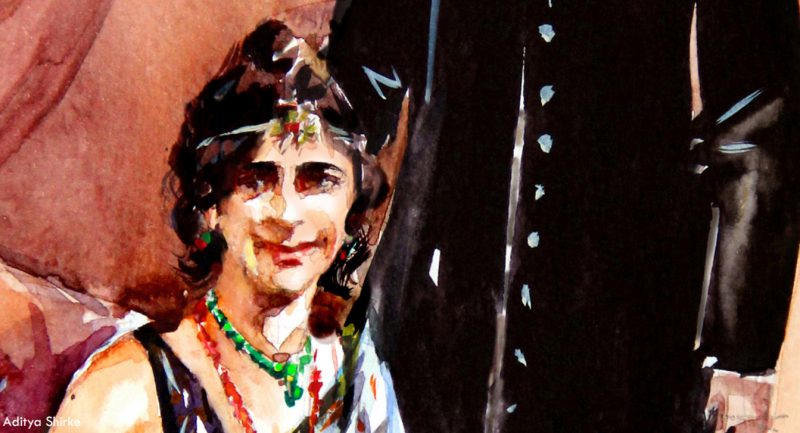
Snehal Shingavi is associate professor of English at the University of Texas, Austin, where he specializes in teaching South Asian literatures in English, Hindi and Urdu. He is the author of The Mahatma Misunderstood, and has translated to wide acclaim the iconic short-story collection Angaaray as well as Bhisham Sahni’s memoir Today’s Pasts. Most recently, he has co-translated Agyeya’s Shekhar: A Life with Vasudha Dalmia.
In this special piece written by him, he talks to us about translating Shekhar: A Life. Let’s take a look!
————————————————————————
‘Agyeya’ (‘the unfathomable‘) is the pen name of Sacchidanand Hiranand Vatsyayan, perhaps one of the most important figures in Hindi literature in the 20th century. He wrote widely—novels, short stories, poetry, journalism, literary criticism—and left a distinct stamp on the character and quality of literary Hindi. As the story goes, he received his moniker from Premchand; Premchand received copies of Agyeya’s short stories from Jainendra Kumar. S.H. Vatsyayan was in prison at the time, and the stories had been smuggled out, so Premchand gave him the title ‘Agyeya.’ In a letter to Jainendra, Premchand wrote: ‘Agyeya’s story was superb . . . People say his stories and prose-poems are better than his poetry’ (as quoted in Nikhil Govind’s Between Love and Freedom).
This exchange between the greatest Hindi novelist of the 20th century and perhaps the greatest Hindi poet in the 20th century is important, as it marks a very clear passing of the torch from a generation about to be eclipsed to a generation that would have to contend with the new challenges of independent India. If Premchand is considered the pre-eminent realist writer of the 20th century, then Agyeya is clearly the most important modernist writer, not only because of his editorship of the various poetry collections called Saptaks that launched the prayogvadi (experimentalist) movement in Hindi poetry, but also because his most important novel, Shekhar: Ek Jeevani, announced the shift in Hindi prose in completely new directions. Incidentally, Premchand’s most important novel, Godan, is written around the same time as Shekhar; Premchand published his novel in 1936, while Agyeya composed his between 1930 and 1932, and then published it in two parts, the first in 1940 and the second in 1942.
While I was a graduate student at the University of California, Berkeley, I worked on and eventually published a translation of Premchand’s first Hindi novel, Sevasadan. The novel was originally written in Urdu and titled Bazaar-e-Husn and then translated into Hindi, in part because Premchand thought the novel would have a better chance of a wider readership in Hindi than in Urdu. The Urdu version of the novel came out soon afterwards. Once I was done with Sevasadan, I began work on translating Shekhar.
There are two things that I think are interesting about this relationship between Premchand and Agyeya. The first thing, at least anecdotally, is that when I talk about translating Premchand, Hindi speakers remember having read something by him at least in school. When I talk about having translated Agyeya, very few people outside of either the literary world of Hindi or the academic world seems to know of whom I am speaking. This has always seemed to me to be a shame, since the quality of Agyeya’s prose is really quite stunning. There is a reason for this difference, and I will come back to it shortly.
The second thing is that even though they are considered to be very different novelists with very different styles, Premchand begins a process of considering the interior life of his characters that is only completed once Agyeya writes a novel almost entirely in the first person. Premchand was always interested in characters that had been deemed unfit for novels (courtesans, peasants, Dalits), but there was a limit to how far he could enter into their imaginations. It takes the changing circumstances of the movement for independence, and even Agyeya’s more radical politics, before the novel can be established on a different footing. When it was published, Shekhar was considered to be an iconoclastic, even scandalous, novel. It took up a number of questions—sexuality, atheism, and perhaps most famously, incest—that novels up to that point had shied away from. The novel’s frank discussion of these questions spoke to a generation of people that were trying to deal with the limitations of social conservatism and religious restrictions as well as the possibilities contained in revolutionary politics.
The thing that has been less considered, however, is the relationship between this new interest in character psychology and development and the transformation of the novel more generally. This is all the more surprising since Agyeya’s novel explicitly talks about the relationship between the narrative of the development of the self (what in German is called the Bildungsroman) and the transformation of the novel in general. What does it feel like to document or to account for the transformation that an individual undergoes? Agyeya’s main character seems to ask the question: how do we account for ourselves? This is even more poignant since the novel is told as a sort of flashback while the main character is awaiting execution by the British for his involvement in revolutionary activism. In the opening pages of the novel, Shekhar wonders: ‘What kind of realization—to what end? What will my death realize—and what realization did my life produce?’ The question is not simply existential—it is the crux of the experience of modernity, when individuals no longer have recourse to religion as explanations for their choices.
In the middle of the second chapter of Agyeya’s Shekhar: A Life, the narrator (Shekhar) wonders about whether his life contains enough adequate material to form a novel. He ruminates about the issue:
But it seems to me that all the challenges that I could remember in my life were mine, were original, were complete stories in themselves, and my life was a brilliant novel. I may have been the only one who felt this way; fascination with one’s own life turns it into something unique. But at the same time I realize that it wasn’t so unique, so idiosyncratic that others couldn’t derive pleasure from it; my private experience contained enough of a germ of collective experience that the collectivity would be able to understand it and see a glimpse of itself in it. My life is a solution in which individuality and ‘type’ are mixed together, without which art is impossible, and without which the novel is impossible.
This description of the relationship between private experience and public understanding is in many ways the core of the novel’s interest: how do we reconcile our almost complete alienation from society, its almost total unwillingness to accept our tiny rebellions, and our deep desire to merge completely into it, to find in it some solace, some understanding of our own angst.
In Shekhar, Agyeya tries to merge the genres of autobiography and novel. He was constantly annoyed, as he describes in his introduction to the novel, that people confused him with the main character, even as he repeatedly drew on his own memories for material for the novel. But he wanted to maintain a separation between himself and Shekhar; the character, Agyeya maintained, had a life and a consciousness that developed according to literary plans rather than the ones he had followed. The novel was written under brutal conditions, while Agyeya was awaiting trial for his involvement in the revolutionary movement against British colonial rule (he had been a part of Bhagat Singh’s Hindustan Socialist Republican Association). Agyeya had been responsible (though the courts eventually dropped the charges) for helping the HSRA build the bombs that they used to try and blow up the train carrying Viceroy Lord Irwin.
Agyeya’s collaborator, Yashpal, described his time in the HSRA this way:
The story I tell is a personal one. It cannot be called history—no individual’s recollections can. But the relationship between the experiences of individuals and the history of society is the same as that of beads to a necklace but without them the necklace cannot be made. While these reminiscences cannot be called history, they do offer profound insights into the events of the revolutionary movement and the thinking which led to the events. (As translated by Corinne Friend in ‘Yashpal: Fighter for Freedom—Writer for Justice’)
Shekhar describes something similar:
The order of my memories has come undone, like when a necklace of pearls falls apart and the spilt pearls are rethreaded haphazardly. I see another scene at the same time that I see this one. It has the same characters, the setting is the same, but its essential theme is completely different. This scene has the same point of view as the other, but in the course of my life it seems as if this scene bears no relation to the other, and if there is a connection then it is that the two scenes are symbols of the simultaneous development of very different feelings . . .
It is this focus on memory—as incomplete, haphazard, chaotic, but still meaningful—as the foundation of narrative that makes Shekhar such a marvelous novel. These were questions that were being asked more generally as India sought to make itself into an independent nation. The novel is remarkable in that it takes independence to be a foregone conclusion. But it is the radical bent of the novel that draws us in. It makes the novel philosophical and introspective, and it also forces us to ask certain questions of ourselves: how authentic are we; what do we intend our lives to mean; when we tell stories about ourselves, how much of these are true; and can we find beauty in even the most insignificant of moments?










